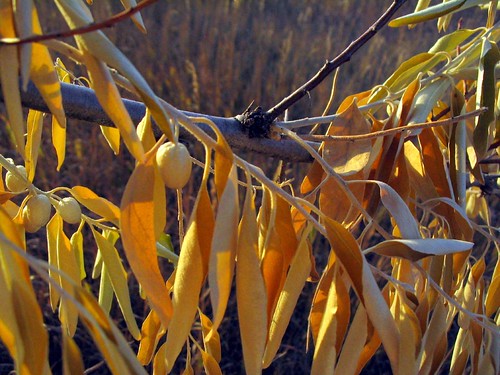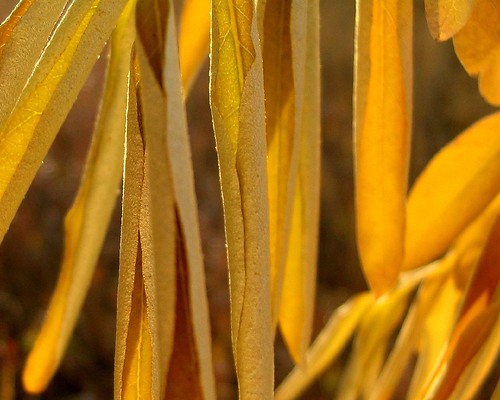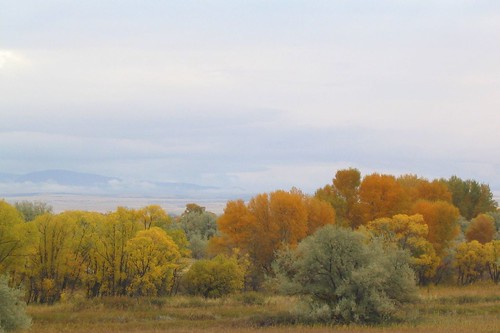Eleagnus angustifolia, Russian Olive

Plant Portrait:
Russian-olives (Elaeagnus angustifolia) aren't a true olive -- their common name (and Latin name) comes from the way their fruit resembles olives. As far as I know the fruits are not edible by humans, but birds like them. Russian Olives are actually a nuisance plant in the west and for sure are considered invasive in the midwest and eastern N.America. They were introduced in the 1800s as ornamental trees, and have spread on their own, sometimes crowding out native species. They spread through waterways by their bouyant seeds -- the "olives."
I love the trees -- their gray green color compliments other landscape colors like the oranges, golds and reds of autumn in Montana. In the photo below, the Russian Olive is the foreground tree, pale green contrasting with the vivid warm colors of the other wetland trees here:
I wish I could use them in my landscape designs, but I try to avoid it because of their invasive nature here in Montana. In the meantime I can enjoy the "wild" Russian olives in places like this wildlife reserve, and I can design with the related native Buffaloberry, Shepherdia argentea, which has a similar color and texture, although it's a shrub not a tree.
There are other plants available for gardens and landscapes that have similar color -- that gorgeous warm gray green, almost silvery. Blue Fescue, Blue Oat Grass, Buffaloberry among the many.


4 comments:
I love Russian olive trees - we had one in our front yard when I was growing up. When I see one, I think of Montana's seasons.
Hi E. Have you ever seen Russian Olives growing in Wisconsin? I know, for me they are essential Montana plants, though they are not native, and I have seen them in other places like down in Utah, but for some reason, I, also equate Russian Olives with Montana autumn, especially along the waterways and in wetlands (where I guess they are doing the most damage by replacing native cottonwoods and willows)
Of course, there are other quintessential Montana plants besides the olives: there are the late winter yellow-gold and chartreuse willows and burgundy red dogwoods in the river bottoms. The brilliant cottonwood and aspen yellows and the reds and oranges of Rocky Mountain Maples and oak-leaf sumacs in fall. The colors of sage and rabbitbrush are so similar to the russian olives: Montana wouldn't be the same without those splotches and brushstrokes of grayish blue in the open lands and hillsides.
Then, of course I'm talking about mostly east of the divide. On the other side -- your side -- you have the Larch (!) one of the most incredibly beautiful sights in the Rockies in spring and fall.
hello
iam nadwa from iraq h like this tree and its very butiull and its frut very good tast i like its brawn branch..
http://nadwa-iraq.blogspot.com/
nadwa
We are state certified tree nursery specializing in native plants and trees, shrubs, fern, and perennials as well as pond plants and wetland mitigation species.
Post a Comment